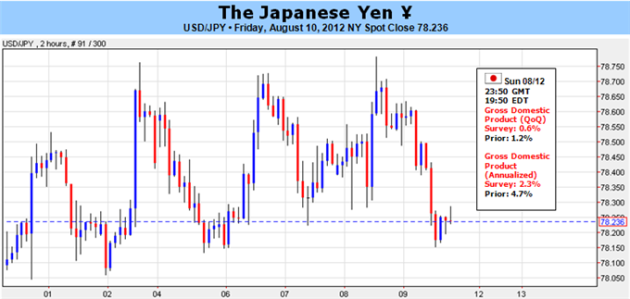
Fundamental Forecast for Japanese Yen: Bullish
- Japanese Yen May Have Topped Against US Dollar
- US Dollar Implications as Volatility Measures Multi-Year Lows
- USD Index Continues to Build Base, JPY at Risk Amid Slower Growth
The Japanese Yen had a strong week, finishing third best among the majors covered by DailyFX Research, while appreciating by a modest +0.24% against the US Dollar. The Japanese Yen was outperformed only by the Canadian Dollar and the British Pound, to which it shed -0.78% and -0.08%, respectively. But most notably, the Japanese Yen was strongest against the Euro; and now the EURJPY has retraced nearly half of its gains during the rally off of the July 24 low. Overall, the Japanese Yen’s outperformance against the Australian Dollar and the Euro pique our interest the greatest, given the implications for a flight to safety predicated around either concerns over China and global growth or the European sovereign debt crisis. Alongside a rise in Spanish sovereign bond yields, we believe a bullish outlook for the Yen is warranted.
Indeed, fundamental event risk this week for the Japanese Yen’s future is important, even though the docket is incredibly thin outside of the preliminary second quarter growth reading due on Monday. But given recent rhetoric out of the Bank of Japan, alongside some disappointing data that necessarily suggests that the Japanese Yen’s strength is hurting exporters’ margins, the GDP print may be the most significant event of the entire month of August, thus making the coming week pivotal for the Yen’s future.
Growth in the second quarter slowed to an annualized pace of +2.3% from +4.7% in the first quarter, according to a Bloomberg News survey. This would thus represent quarterly growth of +0.6% from +1.2%. Growth is likely to slow further in the coming months as the economy moves further away from the devastating natural disasters and ensuing nuclear crisis early last year (the exceptionally strong first quarter reading was in part given the relatively strong March 2012 versus the crisis-impacted March 2011). Nevertheless, Bank of Japan policymakers have indicated, most recently at their meeting this past week that no new stimulus is warranted as the economy improves.
Accordingly, the big picture is that while growth looks lower, policy makers feel otherwise, and a reading at or above the current forecast of +2.3% year-over-year could further deter speculators from betting on new interventionist policies from the Bank of Japan to weaken the Yen. Given the likelihood of this occurring – as a net importer of energy, the year’s lowest oil prices in the second quarter likely cushioned Japanese growth – we think the Yen’s fundamental posture is increasingly bullish.
The paradoxical nature of the Yen’s fundamentals leads us to believe that, by the end of the year, it looks possible for another intervention. A strengthening Japanese economy will lead to increased flows into the Yen, which in turn will hurt exporters’ margins further (Sony Corporation, a major Japanese multinational conglomerate and the country’s biggest exporter of consumer electronics, was forced to slash its full-year profit estimates in early-August due to in part the Yen’s strength). Accordingly, if Japanese businesses are hurting due to Yen strength, the Bank of Japan or the Ministry of Finance could step in ‘fix’ the problem. Should the actual GDP figure beat the estimate, we expect further Yen strength, especially against the US Dollar; whereas a weak reading should result in a stronger USDJPY. –CV
0 comments:
Post a Comment